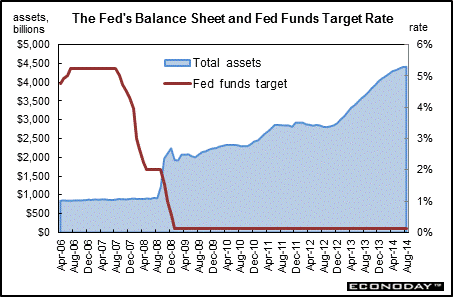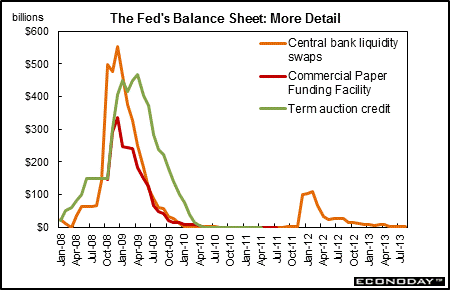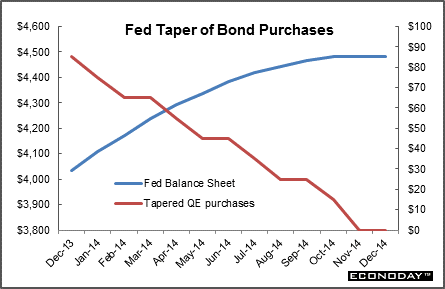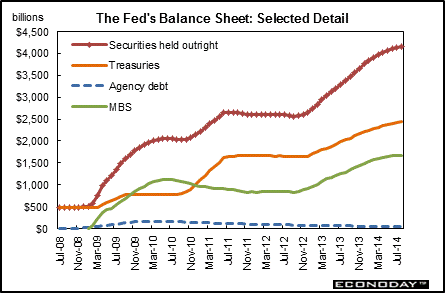
|
Long Term Perspective With interest rates near zero and leaving no room to maneuver, the Fed has switched to quantitative easing as its primary monetary policy tool. Quantitative easing sounds very technical but it can be boiled down to several key ideas. The traditional approach to monetary policy is raising and lowering the fed funds rate — that is the Bank trades reserves for short-term Treasury securities. But with the onset of the subprime crisis in 2007, monetary policy moved beyond just interest rates.
Credit markets froze in 2007 and into 2008 because financial market players were unsure about the quality of many of the bundled securities such as for mortgage-backed assets. Banks and other financial institutions did not know what financial assets to trust and were unwilling to lend with those as collateral.
To improve financial markets, the Fed cut the fed funds target in December 2008 to a range of zero to one quarter percent—essentially zero. But the Fed believed more liquidity was needed than would be provided by a near zero fed funds rate. It added two objectives.
These new objectives were to keep adding to liquidity overall (money available for lending) and to swap low quality assets (such as mortgage-backed securities with subprime loans) for high quality, highly liquid assets (Fed reserves).
Later (in March 2009), the Fed announced that it would buy long-term Treasury securities to add liquidity to financial markets and to bring down longer-term interest rates—more quantitative easing outside the realm of moving short-term interest rates.
Here are summary points about quantitative easing:
Traditional monetary policy raises or lowers short-term interest rates by swapping reserves for short-term Treasury securities.
Quantitative easing uses the Fed's balance sheet to add liquidity without changing interest rates. The Fed swaps reserves for illiquid assets already in the financial markets and for high-quality assets that have longer maturities than the Fed normally buys.
When the Fed conducts quantitative easing, it uses its ability to pay interest on bank reserves to keep the fed funds rate from falling below the desired level.
More recently, the Fed has used its balance sheet to shift interest rates, pushing down long-term rates, with Operation Twist, QE3, and QE4.
The Fed's quantitative easing is reflected in the massive surge in total assets starting in the autumn of 2008. Total assets include such diverse items as U.S. Treasury securities, federal agency debt securities (such as Fannie Mae and Freddie Mac), mortgage-backed securities, repurchase agreements, term auction credit, primary credit (discount window), secondary credit, seasonal credit, primary dealer credit, asset-backed commercial paper money market, credit extended to AIG, Term Asset-Backed Securities Loan Facility, net portfolio holdings of Commercial Paper Funding Facility LLC, net portfolio holdings of LLCs funded through the Money Market Investor Funding Facility, net portfolio holdings of Maiden Lane LLC, Maiden Lane II LLC & Maiden Lane III LLC, float, central bank liquidity swaps, and "other" Federal Reserve assets. However, as of 2013 and somewhat earlier, most of the special facilities were wound down.
Short Term Perspective Early in 2010, the Fed started preparing markets for the start of unwinding the massive expansion of its balance sheet. The April 28, 2010 FOMC statement confirmed that its special lending programs have largely concluded with one remaining special lending facility being wound down.
"In light of improved functioning of financial markets, the Federal Reserve has closed all but one of the special liquidity facilities that it created to support markets during the crisis. The only remaining such program, the Term Asset-Backed Securities Loan Facility, closed on June 30 for loans backed by new-issue commercial mortgage-backed securities; it closed on March 31 for loans backed by all other types of collateral."
The closing of these facilities is reflected in a number of balance sheet items. However, the Fed reopened central bank liquidity swaps to help ease liquidity problems in Europe related to concerns over sovereign debt difficulties for Greece, Spain, and some other European countries.
Early in 2010, the Fed's focus was on when and exactly how to unwind its balance sheet expansion. However, a softening in the recovery in mid-2010 and extremely low inflation at the consumer level resulting in the Fed voting at the November 2-3, 2010 policy meeting to implement another round of quantitative easing—or QE2.
The second round resulted in the Fed buying an additional $600 billion in long-term Treasuries through the end of the second quarter of 2011. The additional purchases of Treasuries were on top of the Fed's decision to reinvest pay down on agency debt and mortgage-backed securities into longer-term Treasuries.
QE3 was announced at the September 12-13, 2012. The Fed will purchase additional agency mortgage-backed securities at a pace of $40 billion per month. No end date was stated. This policy was affirmed through the September 17-18, 2013 FOMC meeting.
At its December 2012 meeting, the Fed announced a new purchases program of Treasuries of initially $45 billion per month. This so-called QE4 (although some call it an extension of QE3) replaced Operation Twist, began in January 2013 and had no specific timetable.
As of the December 2013 FOMC meeting, the Fed began to slow the pace of bond purchases—still adding to the balance sheet but less rapidly. This deceleration in asset purchases was continued through the September 16-17 FOMC meeting. Additions to the Fed's balance sheet ended in October 2014. As of October 2014, there was no guidance on when unwinding will begin.
The Fed's balance sheet at the end of November 2014 was $4.486 trillion—up from about $1 trillion prior to the start of quantitative easing.
The big item still on the Fed's balance sheet from expansion is secutities held outright. This includes the huge runup in mortgage-backed securities held by the Fed. A developing debate within the Fed is what to do with the MBSs. The Fed can let them mature (a slow process), gradually sell them, or a combination of these two actions. Currently, the Fed has decided to reinvest the paydown on mortgage-backed securities and agency debt with purchases of Treasuries. Securities held outright continue to grow with purchases of mortgage-backed securities (QE3) and Treasuries (QE4). It should be noted that the Fed has not given its programs official numerical designations for various rounds of QE. Some economists lump the latest round of purchases of long-term Treasuries into their designation of QE3 (combined MBS and Treasuries even though the start dates differed).
|
||||||||||
| Legal Notices | ©Copyright 1998-2024 Econoday, Inc. |
powered by
![[Econoday]](images/logo.gif)
![[Apple App Store]](/images/AppleAppStore.png) ![[Econoday on Kindle]](/images/kindle.jpg) 
|
|||||||||



